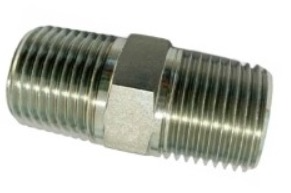Welcome to the world where fluid control meets extraordinary strength. It’s the realm of High Pressure NPT Fittings. In this exploration, we’ll uncover the importance of these fittings. We’ll look at their role in tough and efficient environments. Join us in understanding how these fittings go beyond conventional limits. They enable seamless fluid control in high-pressure scenarios. Let’s explore the transition from standard evolution to material intricacies. Welcome to the power beyond limits.
NPT Fittings: A Closer Look
NPT, or National Pipe Thread, is a standardized thread pattern. It is widely used for pipes and fittings. Its tapered design allows for a tight seal, essential in fluid systems. NPT threads are efficient at preventing leaks. They also provide a secure connection.
NPT fittings were originally designed for low-pressure applications. However, they have evolved to meet the demands of high-pressure environments. The thread’s taper enhances sealing capabilities. This makes it versatile and adaptable to the challenges presented by elevated pressure systems.
What is the maximum pressure for NPT fittings?
The maximum pressure for NPT fittings can vary. Factors such as size, material, and application influence it. Typically, NPT fittings can handle pressures ranging from 1,000 to 10,000 psi. When selecting NPT fittings for specific high-pressure applications, consider these factors. It’s crucial.
Advantages of High Pressure NPT Fittings
A. Enhanced Durability and Reliability
High-pressure NPT fittings excel in durability. They ensure robust performance even in demanding conditions. Their construction, often from materials like stainless steel, enhances longevity. This makes them reliable components in critical fluid systems.
B. Efficient Fluid Control Mechanisms
The design of high-pressure NPT fittings allows for precise fluid control. The taper of the threads contributes to effective sealing. It minimizes the risk of leaks. It ensures efficient regulation of fluid flow in high-pressure environments.
C. Applications Across Industries
From aerospace to industrial manufacturing, high-pressure NPT fittings find diverse applications. Their adaptability and reliability make them integral in various industries. Efficient fluid control under high pressure is paramount.
Different Types of High Pressure NPT Fittings
A. High-Pressure NPT Elbows
High-pressure NPT elbows facilitate changes in pipe direction. They maintain the integrity of the high-pressure system. Their design minimizes turbulence, crucial for applications where smooth fluid flow is essential.
B. NPT Couplings for Intensive Applications
NPT couplings provide a secure connection between pipes in high-pressure scenarios. Their robust construction ensures stability. This makes them suitable for intensive applications where reliability is non-negotiable.
C. NPT Tees: Balancing Flow in High-Pressure Systems
NPT tees play a vital role in balancing fluid flow in high-pressure systems. Their design allows for the diversion of fluid in different directions. This contributes to efficient distribution within the system.
Materials Matter: High Pressure NPT Fittings Composition
A. Stainless Steel: The Powerhouse Material
Stainless steel stands out as the material of choice for high-pressure NPT fittings. Its corrosion resistance and durability make it ideal for intense pressure environments.
B. Other Material Considerations for Specialized Needs
In certain specialized applications, materials like brass or alloys may be considered. This is based on factors such as chemical compatibility or specific industry requirements. Tailoring material choices ensures optimal performance in diverse settings.
Performance Characteristics of High Pressure NPT Fittings
A. Pressure Ratings and Their Significance
Understanding pressure ratings is crucial when working with high-pressure NPT fittings. These ratings denote the maximum pressure a fitting can withstand. It emphasizes the importance of selecting fittings. The fittings must align with the operational pressure requirements.
B. Temperature Tolerance: Operating Beyond the Norm
High-pressure NPT fittings exhibit impressive temperature tolerance. Their design allows for operation beyond standard temperature ranges. This makes them suitable for applications where extreme temperatures are a consideration.
Compatibility and Interchangeability
A. Ensuring Seamless Integration
High-pressure NPT fittings are designed for seamless integration into various systems. Ensuring compatibility with existing components is essential for maintaining system integrity and performance.
B. Interchangeability with Existing Systems
NPT threads are standardized, which allows them to be interchanged. This allows for flexibility when modifying or expanding systems. This feature adds versatility to high-pressure NPT fittings. This allows them to adapt to evolving operational needs.
High Pressure NPT Fittings vs. Other Standards
A. Comparing NPT to NPTF and Other Thread Standards
NPT fittings excel in high-pressure scenarios. It’s essential to consider alternatives. These include NPTF (National Pipe Taper Fuel) and other thread standards. Understanding the nuances helps in selecting the most suitable fittings for specific applications.
B. Advantages in High-Pressure Scenarios
NPT fittings offer distinct advantages in high-pressure scenarios. This is primarily due to their tapered design, which enhances sealing capabilities. NPT fittings are reliable and efficient. They work well in applications with high pressures.
User Guide: Selecting the Right High Pressure NPT Fittings
A. Assessing System Requirements
Start by assessing system requirements to choose the right high-pressure NPT fittings. Pressure levels, fluid type, and temperature guide the selection process.
B. Tailoring Fitting Choices to Operational Needs
Each application comes with unique operational needs. Tailoring fitting choices based on these needs ensures that high-pressure NPT fittings align perfectly with the demands of the system. This optimization improves overall performance.
Challenges and Solutions in High Pressure NPT Fitting Applications
A. Overcoming Common Challenges
High-pressure applications pose specific challenges, including potential leaks or stress on fittings. Understanding and addressing these challenges ensure the reliable and safe operation of NPT fittings in intense pressure environments.
B. Innovations as Solutions
Ongoing innovations in high-pressure NPT fitting design contribute to addressing challenges. New materials pave the way for solutions. Enhanced sealing technologies and improved manufacturing processes are also contributing. They elevate the performance of these fittings.
Conclusion
We conclude our exploration of high-pressure NPT fittings. It’s clear that these components exceed conventional fluid control limits. Their tapered design, robust materials, and adaptability make them powerful assets. They perform well in applications with extraordinary pressure levels.
High-pressure NPT fittings are indispensable components. They provide efficient and reliable fluid control. They are versatile and used in aerospace engineering and industrial manufacturing. They go beyond limits.
Post time: Jan-26-2024


